Abstract
At present, in the situation that wind power penetration is increasing year by year, the use of a hybrid energy storage system (HESS) to smooth out wind power fluctuations becomes an effective method. However, the existing control strategy has the problem of inadequate utilization of fluctuating power. In this paper, we propose a control strategy for smoothing wind power fluctuations based on double Kalman filters with adaptive adjustment of the state of charge (SOC). Firstly, considering the wind power’s active power grid constraint, the parameters of the dual Kalman filter are adaptively adjusted according to the original output power to obtain the target grid power synchronously, and the total smoothing command of the energy storage system is determined with the goal of improving the SOC of the lithium battery. On this basis, the SOC of the supercapacitor is considered to be improved, and the adaptive low-pass filter is used for the secondary distribution of the energy storage power command to achieve fine-grained management of the output power of HESS. The final simulation results show that the obtained smoothed wind power satisfies the 1 min and 10 min fluctuation criteria, and the minimum capacity required for lithium batteries is reduced by 0.07 MW·h under the same initial conditions as in the proposed method in this paper; it can use the fluctuating power when the SOC crosses the limit, and has a regulating effect on the SOC of HESS to improve the wind power smoothing ability and realize the stable grid-connection requirement of wind power.
1. Introduction
Wind power is considered to be one of the most promising ways to obtain energy in the future; however, the random nature of wind energy leads to the deterioration of wind power, which causes the large-scale wind power grid connection to seriously affect the power quality [1]. The impact of power fluctuations in long-distance transmission mode is further enhanced, posing a threat to the safe operation of the power system. Power companies around the world have made clear requirements for the rate of change of active power of wind farms, according to [2,3], as shown in Table 1. For this reason, the wind generation power that exceeds the grid connection criteria must be controlled [4]; adding energy storage systems for fluctuating power smoothing can effectively improve the penetration rate of wind power and grid connection credibility [5]. HESS has the flexibility to charge and discharge both high energy density and power density. The advantages of large [6], used to smooth out wind power fluctuations, can effectively reduce the impact of wind farm output power on the grid. There are several data processing methods such as the Fourier transform, wavelet analysis, first-order low-pass filtering and related algorithms, sliding average filtering [7], Kalman filtering [8], and other methods such as modal decomposition and model predictive control [9,10] for wind power fluctuation smoothing strategies. The challenge is how to obtain the target power to meet the grid-connection requirements and to make the fluctuating power reasonably distributed among different types of energy storage devices, both of which are the key to the control strategy of smoothing wind power fluctuations with HESS.
There are many ways to obtain the target grid-connected power curve, which directly affects the final grid-connected power quality [11,12]. The low-frequency component of wind power is used as the grid-connected target power by the frequency division method [13], which can ensure the stable grid-connected demand of wind power, but in practical applications there is a situation where useful signals and noise overlap with one another, which increases the demand capacity of energy storage equipment to a certain extent to meet the technical requirements. Sun et al. [14] applied a model predictive control algorithm to obtain the total output curve of energy storage with smooth wind power fluctuation, and the optimal grid-connected power was obtained by considering the volatility constraint. However, the algorithm operates with economic optimization and process control hierarchical control, making the dynamic economic performance gradually fail to meet the actual demand; He et al. [15] established a wind-photovoltaic-battery-thermal energy storage hybrid system to determine the optimal operating threshold of the power block with minimum net present value cost and probability of power supply loss, achieving better economy and reliability, but lacking consideration of SOC regulation of the energy storage device. In addition, filtering algorithms are widely used in smoothing the fluctuating power of wind power generation due to their high efficiency and stability. Zheng et al. [16] achieved effective noise reduction in wind power under the influence of complex power quality disturbances by using multiple filters to obtain the optimal output power according to constraints based on the denoising of power quality disturbances, based on Wiener filtering; however, it was not possible to make effective use of fluctuating power, thus increasing the energy storage capacity of smoothing power. Since the Kalman filter has good real-time performance, it can be used as a reliable solution for real-time decomposition of wind power output power, Sun et al. [17] adopted the Kalman filter to attain the target curve and established a hybrid energy storage double-stack self-cycling coordinated control strategy, which can improve power quality, extend the service life of energy storage devices, and improve the working condition of energy storage devices. However, the single filter only smooths out the fluctuating power through the remaining capacity of the energy storage device and cannot achieve the dynamic utilization of fluctuating power for the purpose of adjusting SOC. To this end, this paper considers the use of dual Kalman filters operating in parallel and cooperating with each other to regulate the SOC of energy storage using fluctuating power, which achieves the purpose of smoothing out fluctuations while improving the economy of the united system.

Table 1.
Fluctuation standard.
Table 1.
Fluctuation standard.
| Country | Company | Active Power Fluctuation Standard | ||
|---|---|---|---|---|
| Denmark | Eltra&Elkraft | 1 min fluctuation less than or equal to 5% of the maximum power of the wind farm [18] | ||
| USA | FERC | 1 min fluctuation less than 10% of installed capacity [19] | ||
| UK | National Grid | 1 min fluctuation is less than 10 MW, not more than 3 times the 10 min fluctuation [20] | ||
| Ireland | ESBNG | 1 min fluctuation is limited according to the wind farm capacity level [21]: | ||
| Less than 5% of installed capacity (less than 100 MW) | ||||
| Less than 4% of installed capacity (100–200 MW) | ||||
| Less than 2% of installed capacity (more than 200 MW) | ||||
| China | —— | Fluctuation is limited according to the wind farm capacity level [22]: | ||
| 1 min | 10 min | Wind farm installed capacity | ||
| Less than 3 MW | Less than 10 MW | Less than 30 MW | ||
| Less than 10% of installed capacity | Less than 1/3 of installed capacity | 30–150 MW | ||
| Less than 15 MW | Less than 50 MW | More than 150 MW | ||
The deployment of a certain capacity of energy storage on the wind farm side has become an important initiative for the future development of wind power generation [23,24]. Many scholars have studied how to achieve adaptive regulation of the SOC of HESS to give full play to energy storage on the basis of meeting the requirements of grid connection. Energy management using signal decomposition and reconstruction can fully consider the characteristics of different energy storage media, and the reasonable determination of decomposition coefficients during the real-time operation of the system is the research focus of such methods [25,26]. Cheng et al. [27] used the wavelet transform method to establish the relationship between the frequency characteristics of the energy storage medium and the number of wavelet transform decomposition layers for optimizing the number of decomposition layers, which can reasonably distribute fluctuating power, but does not consider the online dynamic update process. The medium and high frequency components of the wind power output power after using the empirical mode decomposition (EMD) are borne by the HESS, which reduces the charging and discharging time of the energy storage device [28]. In the case that the original signal is not a pure noise signal, and the EMD is prone to the modal mixing problem. In addition to the signal decomposition method, Ghavidel et al. [29] proposed an observer-based HESS control strategy to achieve a high-power supply, which can provide a suitable control performance and ensure the stability of the entire system; however, this strategy lacks the ability to regulate the interoperability of the SOC between different energy storage media. In addition, the use of model predictive control for energy management of HESS has the advantages of model prediction and rolling optimization [30], but the dynamic economy of the classical hierarchical control method needs further improvement; Considering the dynamic operation characteristics of the system, the adaptive sliding average filtering algorithm with online real-time adjustment of the sliding window can effectively solve the problem of difficult coordination between smoothing fluctuating power and reducing the burden of the energy storage battery [31]; but the suppression of impulsive disturbances is poor, and the fluctuating power currently of the SOC state offset cannot be effectively adjusted, which makes it difficult to coordinate with the energy storage smoothing power obtained by the upper double Kalman filtering; a neural network applied to the coordinated optimal control of HESS is superior to the proportional-integral-derivative (PID) control [32], but the stability in long-term operation needs further consideration. In order to cope with the complex and variable environment in which the wind power system is located, this paper uses PID control. In order to take into account the adaptive adjustment of the SOC of energy storage and the reasonable distribution of fluctuating power among HESS during the dynamic operation of the system, the capacity configuration of the energy storage equipment is improved [33], while cooperating with the Kalman filtering used in the upper layer to obtain the energy storage leveling power. In this paper, a variable time constant first-order low-pass filtering algorithm is used to adaptively adjust the filtering time constant based on the SOC of the energy storage and real-time smoothing power, thus adjusting the cutoff frequency to achieve a reasonable distribution of HESS power and improve the system economy [34].
The above literature has contributed to the study of smoothing power fluctuations on wind farms, and also has provided a good reference for improving the SOC of energy storage to improve system economics, of which there are also several factors to consider: (1) The time delay characteristics of the algorithm for obtaining the grid-connected target power needs to be considered; the fluctuating power in the real-time smoothing process of wind power to regulate the SOC of energy storage should be used to improve the reasonableness of HESS power output; (2) The ability to use different energy storage media to smooth out the fluctuating power when the SOC drifts under the long-time operation of HESS needs to be considered to achieve effective control of HESS—as should having adaptive SOC regulation capability among different energy storage media to improve the economics of the co-generation system. Considering these two aspects, a smoothing control strategy for wind power fluctuating power based on the dynamic adjustment of the SOC of HESS is proposed.
The main parts of the paper are organized as follows: Section 2 introduces the working mechanism of HESS for smoothing wind power fluctuations and establishes a model of the wind power-HESS co-generation system. Section 3 proposes an adaptive control strategy considering the SOC of HESS. Section 4 performs a simulation analysis in MATLAB. Finally, the paper is concluded in Section 5.
2. Wind Power-HESS Co-Generation System
The hybrid energy storage system model for wind power fluctuation smoothing studied in this paper is shown in Figure 1. The HESS consists of lithium iron phosphate batteries and supercapacitors. The system adopts a common AC bus structure more suitable for fluctuation smoothing in large and medium-sized wind farms, and the lithium batteries and supercapacitors are connected to the grid-connected AC bus through isolation transformers after the mutually independent DC/AC converters [35,36]. The central controller continuously controls the converters of Li-ion battery and supercapacitor to regulate their charging/discharging power according to the output power of wind farm and SOC of energy storage devices, thus smoothing the output power of wind farm. denotes the original output power of wind farm; and denote the charging/discharging power of Li-ion battery and supercapacitor, respectively; denotes the actual grid-connected power of wind farm; and denote the real-time charge state of Li-ion battery and supercapacitor, respectively.
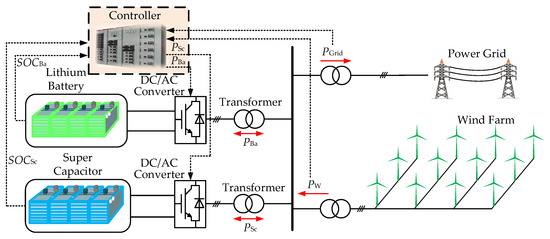
Figure 1.
Structure of wind power system containing HESS.
According to the energy flow in Figure 1, the final output power obtained from the wind farm power after smoothing by the energy storage system is as follows:
where the power of the HESS can be described as follows:
The energy stored in HESS (MW·h) at t is formulated as [37]:
where and are the charging and discharging efficiencies of super-capacitors, respectively; and are the charging and discharging efficiencies of batteries, respectively; ΔT is the sampling period, which is set as 5 s in this paper.
3. Control Strategy for Smoothing out Power Fluctuations in HESS
Long continuous operation will cause overcharging or complete discharge of the battery energy storage system (BESS) or the supercapacitor energy storage system (SESS); according to regulation of total HESS action power and fixed cutoff frequency for secondary distribution of power command, cannot be guaranteed. Therefore, in the total energy storage action power acquisition, this paper considers the fluctuation requirements of grid-connected power for 1 min, 10 min, and the SOC recovery demand of the lithium battery, and uses the adaptive double Kalman filter to determine the total leveling power of HESS, as shown in Figure 2, “Total energy storage power acquisition”. The filter 1 acquires the target power to meet the grid-connected standard, while the filter 2 operates at a higher standard to determine the total energy storage power of the HESS based on the SOC of the battery with filter 1 or 2, to achieve the purpose of SOC regulation by using fluctuating power.
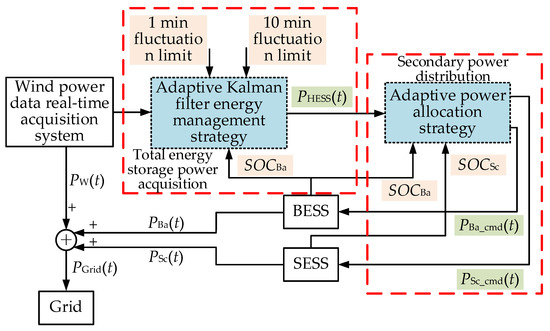
Figure 2.
Adaptive energy management strategy for HESS.
In the secondary distribution of energy storage power, the SOC adjustment of SESS is realized based on and using an adaptive low-pass filter with variable time constants for frequency division to obtain the lithium battery and supercapacitor action power commands ( and ). The control structure is shown as “Secondary power distribution” in Figure 2; this part cooperates with the smoothing power of HESS obtained from the upper layer, and the adaptive low-pass filter realizes the online distribution of action power while taking into account the SOC correction of SESS and BESS, and finally the fast adjustment strategy of filtering time constant is proposed to further enhance the regulation of the SOC; the complete control strategy realizes the purpose of adjusting the SOC of energy storage online with the fluctuating power of wind power, avoiding the increase of storage capacity configuration caused by the traditional strategy for smoothing fluctuations and improving the system economy.
3.1. Energy Storage Power Acquisition Strategy
In obtaining the total output target of HESS, the main purpose is to automatically adjust the hybrid energy storage power command based on . Firstly, the standard target grid-connected power and the smoothed target grid-connected power are determined adaptively according to the wind power grid-connected power fluctuation index, and on this basis, the difference is made to obtain the charging energy storage power to make of the lithium battery adjusted upward and the discharging energy storage power to make adjusted downward, and finally the total energy storage power target is determined according to the interval in which the of the lithium battery is located, so that the battery maintains a good state of charge. The control structure is shown in Figure 3.
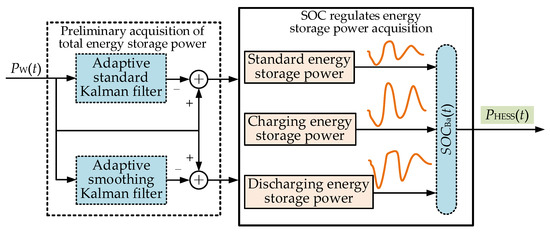
Figure 3.
Energy storage power acquisition based on adaptive double Kalman filter.
3.1.1. Adaptive Acquisition Strategy for Energy Storage Power
The Kalman filter is widely used in many fields such as communication and control due to its superior performance. A better target grid-connected power can also be obtained by adjusting the filter gain when sudden changes in wind farm power occurred. The Kalman filter uses the observed value and the estimated value together to determine the target value. The advantage is that it can use the estimated value to predict the next moment state, and at the same time correct the previous moment estimated value according to the current moment observed value, which has strong real-time and fast convergence speed. The Kalman filter for wind power fluctuation smoothing must establish the corresponding time update equation and state update equation [38], as follows.
Time update equation:
State update equation:
where is the prior estimate of t at t − 1; is the grid connected power of the wind farm at t − 1; is the covariance of a prior estimate; is the covariance of state estimation at time t − 1; is the grid connection value of wind power at time t; is the wind farm output power at time t; is the Kalman filter gain; Q is the covariance of process noise; R is the measurement noise covariance.
The R value in Kalman filter directly affects the target grid-connected power. By introducing as the correction quantity, the value is adaptively adjusted according to the demand of 1 min and 10 min fluctuation quantity of grid-connected power, and the standard grid-connected power and smooth grid-connected power commands are obtained simultaneously. The HESS action power command is adjusted according to the SOC of Li-ion battery to prevent overcharging/discharging of energy storage.
When adaptively acquiring the target grid-connected power, the state update Equation (9) is changed to Equation (10):
where, is the Kalman filter gain correction, x = 0 is the standard Kalman filter correction, and x = 1 is the smooth Kalman filter correction.
The corrected grid connection value of wind power is:
The value is determined based on power fluctuation limits [37]:
where, t is the current time; In Formula (12), i represents the second within 1 min; In Formula (13), i represents the second in 10 min; represents the target grid connected power value at time t − i after smoothing of x Kalman filter, x = 0, 1.
is adaptively adjusted according to the change of fluctuation amount in the time window of 1 min and 10 min at any moment of the target grid-connected power, as shown in Equations (14) and (15):
Among them, in order to make the target grid-connected power obtained by the standard Kalman filter meet the fluctuation requirement, the fluctuation amount of determines the index considering the 20% margin; in order to ensure the SOC improvement effect of Li-ion battery, the fluctuation amount standard of the smooth Kalman filter is set to 20% of the national standard.
The smoothed power of the resulting energy storage after the above adaptive correction is:
where, represents energy storage charging and represents energy storage discharging.
The SOC adjustable energy management strategy for energy storage is determined, based on the different energy storage smoothing power obtained synchronously.
Energy storage power under normal operation:
Energy storage power when of the battery is adjusted upward:
Energy storage power when of the battery is adjusted downward:
The energy storage charge/discharge energy variation under normal operation and when regulation is performed is shown in Figure 4.
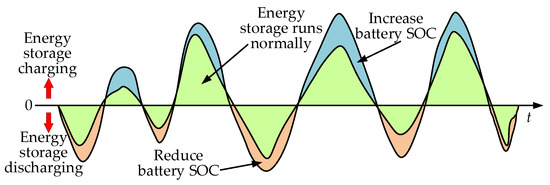
Figure 4.
Schematic of the charge/discharge energy of the regulation of the battery.
3.1.2. Energy Management Mode Based on SOC of Battery
The wind power smoothing strategy based on adaptive dual Kalman filtering for energy management refers to adjusting the next moment of energy storage system action power according to the SOC of lithium battery, and the dual target grid-connected power can ensure the smoothing of wind power fluctuation while improving the SOC of energy storage.
During the operation of the system with the change of the SOC of the lithium battery, the leveling power fluctuation instruction of the energy storage system is changed, and in this paper, the SOC of the battery is divided into 3 levels with and as the upper and lower limits of the normal operating range. As shown in Equation (20):
It should be possible to control the SOC convergence to 50% during the HESS operation to cope with the fluctuation smoothing requirements in the future moments.
The power curve of the energy storage system with the change of to smooth out the fluctuation of wind power is shown in Figure 5. As can be seen in Figure 5, when the energy storage system operates for a long time and the SOC is shifted, the power output target can be changed online while smoothing the power and improving the overcharge and overdischarge of the energy storage system.
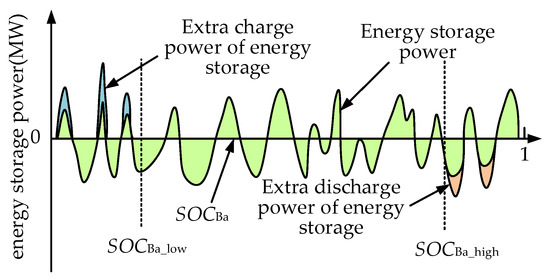
Figure 5.
Changes in the HESS power command when the of battery is regulated.
3.2. Power Allocation Strategy
The adaptively adjustable HESS charging/discharging power is obtained based on the ; the adaptive low-pass filter based on variable time constants takes and as constraints and changes the filtering time constants to realize the secondary distribution of HESS power and obtain the smoothing power command for different energy storage media, as shown in Figure 6, for the specific strategy.
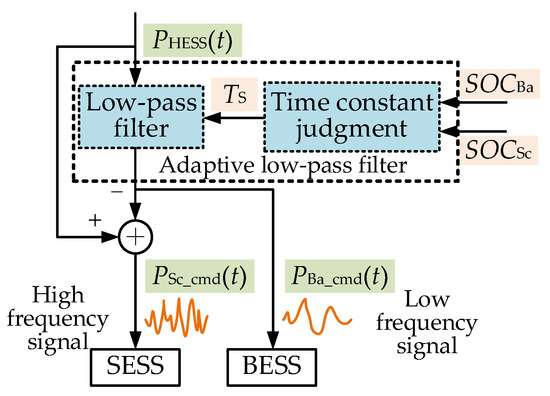
Figure 6.
Power allocation strategy of HESS.
3.2.1. Improve Power Distribution of
After the power distribution of HESS, the fast fluctuation of high frequency is smoothed out by super capacitor, and the change of charging and discharging power is less than that of the battery; there is offset of under long time operation, the first-order low-pass filter is used to realize the power distribution algorithm of energy storage, which is simple and easy to operate, and the adaptive adjustment of time constant on the basis of considering the can improve and complete the reasonable distribution of power of HESS.
The time constant of the first-order low-pass filter is shown in Equation (21):
When decreases, increases; the extracted power fluctuation range will be reduced, which can make the power reference value of the Li-ion battery energy storage system smaller. Conversely, when the cutoff frequency decreases, the power fluctuation range extracted by the filter increases, and the power reference value of the Li-ion battery energy storage system obtained at this time increases accordingly. The filtering time constant adjustment rule to improve on the basis of ensuring is as in Equation (22):
Among these, when the is in the safe range and the is deep charging/discharging as the filter time constant decreases, then the battery output increases to bear more energy storage smoothing power and to reduce the supercapacitor output; when the lithium battery still appears to be deep charging/discharging after the upper adaptive adjustment, while is in the safe range when the filter time constant increases. Then the supercapacitor bears more energy storage smoothing power to alleviate the trend of the lithium battery deep charging/discharging; the adaptive adjustment filter time constant schematic is shown in Figure 7, where and denote the filter time constant limit, > , and denotes the filter time constant value in normal operation.
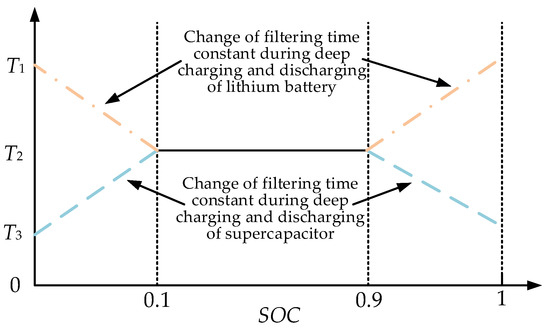
Figure 7.
Adaptive adjustment of filtering time constant for improving .
3.2.2. Improve Power Distribution of
The HESS power output is obtained by improving the upper and lower limits of , and the offset of is adjusted by adaptively changing the filtering time constant; it is meaningful to maintain the stable operation of the energy storage system under long-time operation. The actual operating environment conditions of wind turbines are complex and variable, and in order to fully consider the actual operating problems, the power allocation is carried out with the purpose of improving the SOC recovery speed of the battery.
When ≤ and , according to Equation (20) energy storage system to change the power out to charge the battery, in order to quickly recover in the overcharge/overdischarge state, while reducing the impact of energy storage power change on , defining the filtering time constant.
where the slope k < 0 varies with the SOC of the energy storage, and the charging power in rises rapidly until the SOC stops falling and k keeps its current value. The charge/discharge response time of the lithium battery is from several seconds to tens of minutes, and the charge/discharge response time of supercapacitor is from several milliseconds to several minutes; therefore, the upper and lower limit values of are set to 31.831/1.5915, and the k value is continuously updated in the variable range until returns to normal operation, then , avoiding abrupt changes due to a large slope. Figure 8 shows that the slope increases with decreasing , thus ensuring that the power distribution of HESS is coordinated with the SOC recovery of battery energy storage.
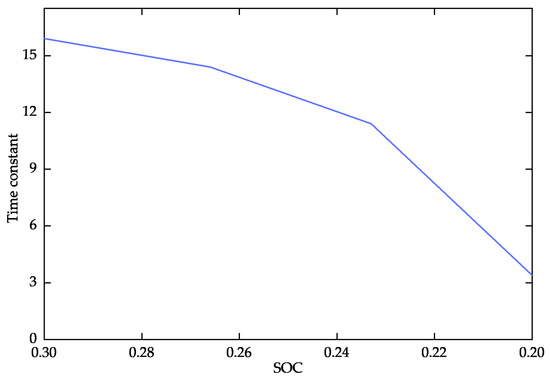
Figure 8.
The slope change of the filter time constant update.
When and , the filtering time constant is updated according to the above rules.
When < < , power distribution is performed according to Section 3.2.1 to improve the SOC of the supercapacitor; prevent algorithm operation errors caused by constraint conflicts, set: 0.1 < , < 0.9.
3.2.3. Simulation Flow of HESS to Smooth out Wind Power Fluctuations
In this paper, the amount of wind power grid-connected power fluctuation is the target constraint, and the adaptive Kalman filter with different grid-connected criteria is used to achieve the purpose of improving the SOC of HESS on the basis of the target grid-connected power, satisfying the fluctuation criteria. In addition, the low-pass filter with a variable filtering time constant is used for power distribution to alleviate the offset of the SOC under the long-time operation of the supercapacitor and lithium battery, and finally, the HESS smoothing out of the wind power fluctuation control is achieved, and the simulation process is shown in Figure 9.
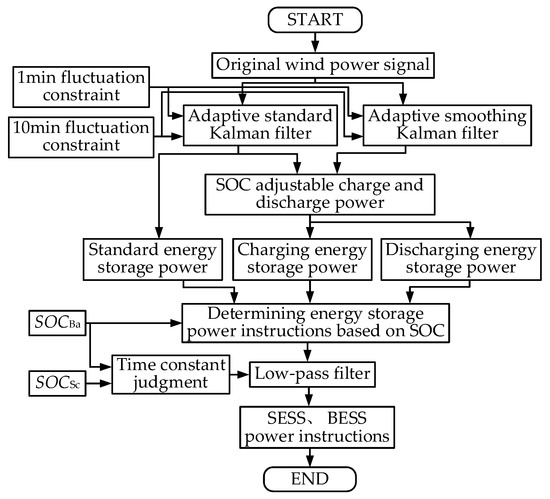
Figure 9.
Simulation process.
- Input the original wind power signal to calculate 1 min, 10 min power fluctuation rate.
- Under the volatility constraint, the standard Kalman filter obtains the target grid-connected power signal and the HESS smoothing power signal ; smooth grid power signal and energy storage smoothing power signal are obtained by using the smooth Kalman filter.
- Obtaining the storage charging power for the upward adjustment of and the storage discharging power for the downward adjustment of based on the storage charging/discharging power at the same moment.
- Adaptive output energy storage smoothing power according to .
- Based on , using an adaptive low-pass filter to achieve secondary distribution of the energy storage power signal, which is borne by different energy storage media according to high and low frequency.
4. Simulation Results
4.1. Simulation Parameter Setting
The proposed method is validated by selecting typical seasonal power data of an actual wind farm in China, with a sampling duration of 24 h, a sampling frequency of 5 s, and an installed capacity of 200 MW, so that the grid fluctuation rate of 1 min meets no more than 15 MW, the grid fluctuation rate of 10 min meets no more than 50 MW, and the initial SOC is set to 0.5. The required parameters for the simulation are set in Table 2 [1,8], It is worth mentioning that the required capacity (MW·h) of BESS and SESS in the simulation parameters, and the rated power (MW) are set for the simulation process to meet the demand of wind power fluctuation smoothing, and the specific energy storage capacity configuration specifications required for the actual application are not included in this study.

Table 2.
Simulation parameters.
4.2. Simulation Analysis
4.2.1. Comparative Analysis of Simulation Results
The simulation analysis uses different Kalman filtering methods to compare with the proposed method; for example, Figure 10 shows the target power obtained from the original output power of wind power using various standards of the Kalman filter. It can be seen that the wind farm output power after standard Kalman filter smoothing, the fluctuation amplitude was significantly reduced to meet the requirements of the grid connection, but did not have the ability to regulate the SOC. After smoothing the Kalman filter smoothing, the grid connection target curve tended to smooth, in order to meet the target, the required power and capacity of energy storage equipment cost too much; the proposed method combines the two, Figure 11 and Figure 12 show the 1 min and 10 min fluctuations of wind power after smoothing, respectively, and Figure 13 shows the 1 min fluctuations of target grid-connected power at . At 19.61 h, it can be seen from Figure 14 that the battery is in an overcharge state, the HESS charging and discharging power is adjusted according to Equation (20), as in Figure 10, to maintain the standard Kalman filtering method in the charging state. In the discharging state, based on the smoothing Kalman filtering method, the purpose of adjusting the SOC on the basis of a small increase in energy storage power is achieved.
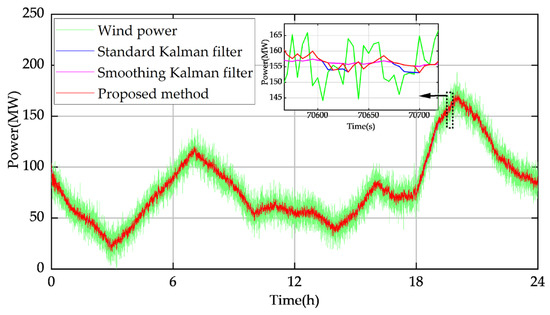
Figure 10.
The wind power before and after smoothing.
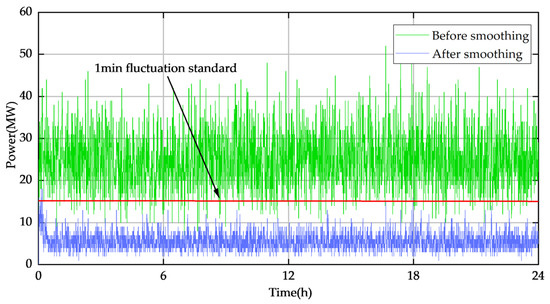
Figure 11.
The amount of fluctuation before and after the 1 min smoothing.
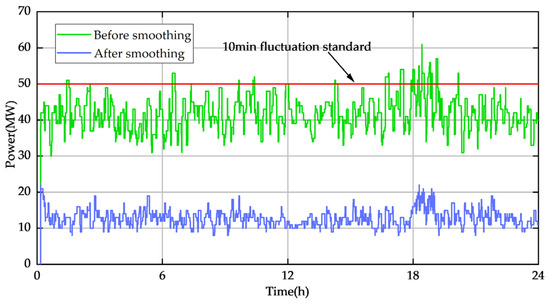
Figure 12.
The amount of fluctuation before and after the 10 min smoothing.
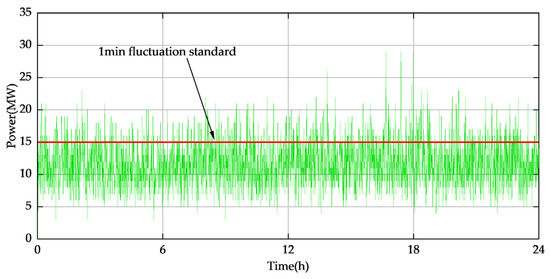
Figure 13.
The amount of fluctuation before and after the smoothing of 1 min at a fixed value.
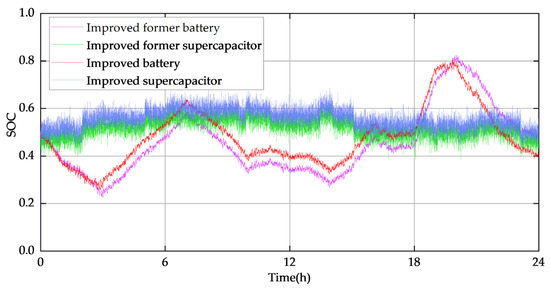
Figure 14.
Comparison of the charge states of HESS before and after the improvement.
The final wind power smoothing effect, as shown in Figure 11 and Figure 12, is measured by the maximum fluctuation amount standard in any 1 min and 10 min time window; the maximum fluctuation amount of 1 min before smoothing is 54 MW, and it is reduced to 14 MW after smoothing; the maximum fluctuation amount of 10 min before smoothing is 61 MW, and it is reduced to 22 MW after smoothing, which meets the active power fluctuation requirement of 200 MW wind farm.
As in Figure 13, the same initial conditions using the Kalman filter fixed amount of measurement noise covariance, that is, the amount of fluctuation of 1 min of the target grid-connected power obtained at ; part of the fluctuation exceeds the fluctuation criterion; if it is made to meet the grid-connected requirements, according to Figure 15, the R value should be fixed at 180, at which the required energy storage cost will be significantly increased.
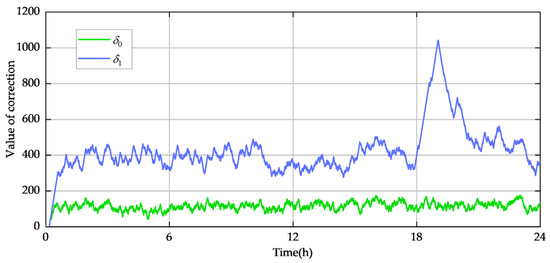
Figure 15.
Adaptive variation of the correction quantity .
The change of the charge state of HESS with adaptive Kalman filtering and the improvement method proposed in this paper are shown in Figure 14, where is shifted at 3 h and 21 h to change the energy storage output according to Equation (20); after the improvement, achieves regulation and rises slightly.
Figure 15 shows the adaptive change of the correction of the measured noise covariance of the proposed method Kalman filter based on Equations (14) and (15); based on the wind power grid standard with a given margin, the correction changes correspondingly as the wind power changes, and the wind power fluctuates significantly at 19 h, the standard Kalman filter meets the fluctuation requirement, does not show significant change, and when the standard is raised to 20% of the national standard, increases to the maximum value of 1043; indicating that the proposed method can achieve adaptive change of the measured noise covariance, and the spike position is particularly significant.
In this paper, the low-pass filter with adaptive time constant is used to divide the frequency to realize the secondary distribution. In order to observe the improvement effect on the SOC of energy storage, the initial SOC of lithium battery is set to 0.15 as shown in Figure 16, and the initial SOC of supercapacitor is 0.75 as shown in Figure 17; the time constant is adjusted according to Equation (22) as shown in Figure 16 and Figure 17, and the variable filtering time constant has a mitigating effect at 1 h when is offset to prevent it from crossing the limit; however, it cannot increase its charging power to regulate the charge state; as shown in Figure 17, crosses the limit at 9 h, and it has an obviously improved effect by changing the filtering time constant. The maximum value of is 0.92 when the filtering time constant is fixed, and the maximum value of is reduced to 0.86 when the adaptive filtering time constant is used.
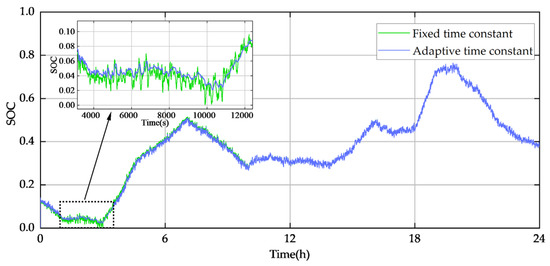
Figure 16.
The change in before and after the change in time constant.
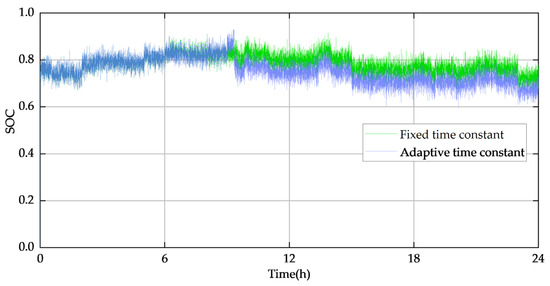
Figure 17.
The change in before and after the change in time constant.
In order to enhance the regulating effect of the strategy proposed in this paper when the of the lithium battery crosses the limit, the coordination between the total output of energy storage and HESS is enhanced by setting the update of the filtering time constant in Section 3.2.2. As shown in Figure 18, the comparison of the SOC changes of the lithium battery and the supercapacitor before and after the improvement, at 2.5 h, the improvement effect of the of the improved strategy battery is better than that before, and the of the supercapacitor appears significant at this time fluctuates, and returns to a normal state after 35 min, which has no effect on the overall change trend.
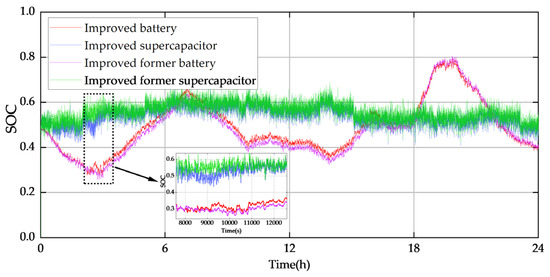
Figure 18.
Comparison of SOC changes between lithium battery and super capacitor before and after improvement.
4.2.2. Capacity Configuration of HESS
It should be noted that the proposed method to improve the SOC of energy storage is achieved by sacrificing the discharging/charging power in the overcharge/overdischarge state of energy storage, which does not affect the overall energy storage power. Figure 19 shows the comparison between the total energy storage output obtained by the proposed method and that of the adaptive Kalman filtering method, where the charging/discharging power of energy storage is adjusted at 2.36 h and 19.17 h, and the maximum power of energy storage is maintained at 33.08 MW. The maximum power of energy storage remains unchanged at 33.08 MW; therefore, only the effect of the proposed method on the configuration of energy storage capacity (MW·h) is considered in this paper.

Figure 19.
Comparison of energy storage charging and discharging power of different methods.
The energy change curve of energy storage is obtained by integrating the charging and discharging power; then the formula for the minimum capacity of energy storage [14] is:
where E is energy. The energy change curves of battery and supercapacitor are shown in Figure 20 and Figure 21, respectively.

Figure 20.
The energy change curve of the battery.
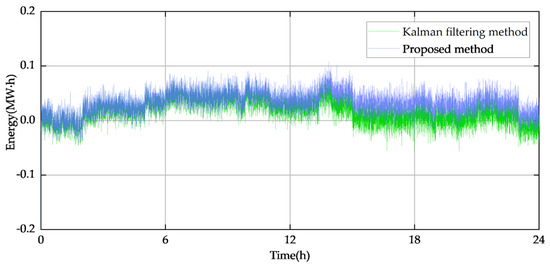
Figure 21.
The energy change curve of the super capacitor.
The minimum capacities of lithium batteries and supercapacitors calculated by Equation (24) for different methods are shown in Table 3.

Table 3.
Minimum capacity required for energy storage.
It can be seen from Table 3 that the minimum capacity required for lithium batteries is reduced by 0.07 MW·h under the method proposed in this paper, while the capacity required for supercapacitors is increased by 0.01 MW·h. The reason is that the adaptive low-pass filter used in this paper for the secondary distribution of energy storage power has the effect of alleviating the deep charging/discharging of supercapacitors without changing the charging/discharging power trend to regulate the SOC; the proposed method in this paper is based on the battery SOC adjustment of HESS smoothing power obtained by the double Kalman filter, adaptive low-pass filter for battery and supercapacitor smoothing power command allocation, to improve the working condition of energy storage device by using fluctuating power to reduce the capacity configuration, the main purpose is to improve the SOC offset caused by charge/discharge imbalance of battery in long-term operation, which can reduce the minimum battery capacity required by the traditional strategy, while the minimum capacity required by supercapacitor will show small fluctuations, and the subsequent addition of neural networks can be considered for optimal control.
In addition, through the adaptive adjustment of the SOC of the battery on the basis of reduced capacity configuration, the fluctuating power can be used to improve the working condition of the battery and avoid its overcharge and overdischarge, thus improving safety, extending the service life of the battery, and further reducing the cost of energy storage.
5. Conclusions
In order to give full play to the regulation of fluctuating power in the storage charge state in the wind power smoothing process, while considering the grid-connected technical requirements of active power on wind farms and the SOC regulation of HESS, a control strategy for HESS smoothing wind power fluctuations considering the SOC safety range is proposed. The conclusions are as follows:
- The proposed strategy adaptively adjusts the target grid-connected power with the wind power grid-connected standard as the target, the obtained smoothed wind power satisfies the 1 min and 10 min fluctuation standard, the maximum fluctuation amount of 1 min is reduced from 54 MW to 14 MW after smoothing, the maximum fluctuation amount of 10 min is reduced from 61 MW to 22 MW after smoothing, and part of the power cannot meet the requirements under the same initial conditions using the traditional method.
- The proposed parameter adaptive strategy can realize automatic update according to the real-time wind power situation, and has the ability to actively adjust the charge state of the lithium battery when it is shifted, so as to improve the working state of the battery and achieve a balance between the smoothing fluctuation performance and the operating economy of the system.
- Considering the balance of charge states between different energy storage media, using low-pass filters with variable time constants for power distribution to achieve coordinated control of energy storage power, which has a certain alleviating effect when the charge state of lithium batteries crosses the limit and has a regulating effect on the charge state of supercapacitors, with the maximum value reduced from 0.92 to 0.86 after improvement.
- The key to the proposed strategy is to sacrifice the energy storage power of the HESS when the charge state of energy storage crosses the limit as a premise, without affecting the maximum energy storage power of energy storage, which can reduce the required capacity of battery energy storage, and the minimum capacity required for lithium batteries under the same conditions is reduced by 0.07 MW·h.
Author Contributions
Conceptualization, N.S. and H.D.; methodology, L.Q.; software, L.Q.; validation, L.Q. and H.D.; formal analysis, H.D.; investigation, L.Q.; resources, N.S.; data curation, L.Q.; writing—original draft preparation, L.Q.; writing—review and editing, L.Q. and H.D.; project administration, H.D. All authors have read and agreed to the published version of the manuscript.
Funding
This research was funded by Science and Technology Plan Project of Jiayuguan City, Gansu Province, China, grant number 22-35.
Data Availability Statement
Not applicable.
Conflicts of Interest
The authors declare that they have no conflict of interest to report regarding the present study.
Nomenclature
| Abbreviation | |
| HESS | Hybrid Energy Storage System |
| SOC | State of Charge |
| EMD | Empirical Mode Decomposition |
| BESS | Battery Energy Storage System |
| SESS | Super Capacitor Energy Storage System |
| Variables and constants | |
| Original output power of wind farm | |
| Charging/discharging power of lithium battery | |
| Charging/discharging power of super capacitor | |
| Actual grid-connected power of wind farm | |
| Energy change of super capacitor over time | |
| Energy change of battery over time | |
| Charging efficiency of super capacitor | |
| Discharging efficiency of super capacitor | |
| Charging efficiency of battery | |
| Discharging efficiency of battery | |
| ΔT | Sampling period |
| SOC of lithium battery | |
| SOC of super capacitor | |
| Output power of HESS | |
| Action power instruction for lithium battery | |
| Action power instruction for super capacitor | |
| G(t) | Kalman filter gain |
| Q | Process noise covariance |
| R | Measurement noise covariance |
| The introduced correction amount | |
| t | Current time |
| i | Every second |
| x | Serial number of Kalman filter, x = 0, 1 |
| Energy storage charge and discharge power | |
| Upper limit of SOC | |
| Lower limit of SOC | |
| , | Time constant of low-pass filter |
| Cut-off frequency of low-pass filter | |
| k | Slope of filter time constant with SOC |
| E | Energy change of the energy storage |
| C | Minimum capacity of the energy storage |
References
- Pinazo, M.A.; Martinez, J.L.R. Intermittent power control in wind turbines integrated into a hybrid energy storage system based on a new state-of-charge management algorithm. J. Energy Storage 2022, 54, 105223. [Google Scholar]
- Fox, B. Wind Power Integration: Connection and System Operational Aspects; Wiley: New York, NY, USA, 2014; p. 288. [Google Scholar]
- ERCOT. PRR771—Ramp Rate Limitation of 10% per Minute of On-Line Installed Capacity for Wind-Powered Generation Resources [EB/OL]. Available online: http://www.ercot.com/mktrules/issues/prr/750-774/771 (accessed on 8 December 2013).
- Takayama, T.; Otani, T.; Kobayashi, J.; Iwamoto, S. A study of wind power curtailment using frequency sensitivity and transient stability. In Proceedings of the 2015 IEEE innovative smart grid technologies–Asia, Bangkok, Thailand, 3–6 November 2015. [Google Scholar]
- Sun, Y.S.; Zhang, G.W.; Tang, X.S.; Jia, D.Q.; Cao, Z.H. Research on MPC dual energy storage control strategy under wind power fluctuation suppression. J. Electr. Technol. 2019, 34, 571–578. [Google Scholar]
- Zhu, Y.W.; Lv, L.; Liu, Y.B.; Zhou, C.Y.; Zhang, Y.Q. Smooth control strategy of hybrid energy storage system based on dynamic wavelet decomposition. Electr. Power Constr. 2017, 38, 111–119. [Google Scholar]
- Malan; Xie, L.R.; Ye, L.; Yu, L.P.; Wang, K.F. Wind power fluctuation suppression strategy based on hybrid energy storage bi-level programming model. Power Grid Technol. 2022, 46, 1016–1029. [Google Scholar]
- Wu, J. Research on Control Strategy and Capacity Optimization Configuration of Hybrid Energy Storage System to Stabilize Wind Power Fluctuation. Ph.D. Thesis, Hefei University of Technology, Hefei, China, 2019. [Google Scholar]
- Li, M.; Li, Y.; Choi, S.S. Dispatch planning of a wide-area wind power-energy storage scheme based on ensemble empirical mode decomposition technique. IEEE Trans. Sustain. Energy 2021, 12, 1275–1288. [Google Scholar] [CrossRef]
- Lamsal, D.; Sreeram, V.; Mishra, Y.; Kumar, D. Output power smoothing control approaches for wind and photovoltaic generation systems: A review. Renew. Sustain. Energy 2019, 113, 109245. [Google Scholar] [CrossRef]
- Wei, S.F.; Lu, Q.; Hu, L.K.; Deng, H.H. Research on power feedforward voltage stabilization control strategy based on hybrid energy storage. J. Guangxi Univ. (Nat. Sci. Ed.) 2017, 42, 2050–2058. [Google Scholar]
- Wan, C.; Qian, W.; Zhao, C.; Song, Y.; Yang, G. Probabilistic Forecasting Based Sizing and Control of Hybrid Energy Storage for Wind Power Smoothing. IEEE Trans. Sustain. Energy 2021, 12, 1841–1852. [Google Scholar] [CrossRef]
- Lv, C.X.; Li, X.R.; Hu, L.H.; Yin, L.; Hu, J. Smoothing strategy of multi-type energy storage system based on wavelet frequency division and double-layer fuzzy control. Power Syst. Autom. 2015, 39, 21–29. [Google Scholar]
- Sun, Y.S.; Tang, X.S.; Sun, X.Z.; Jia, D.Q.; Wang, P.; Zhang, G.W. Research on coordinated control strategy of multi-type energy storage based on MPC-HHT. Chin. J. Electr. Eng. 2018, 38, 2580–2588+2826. [Google Scholar]
- He, Y.; Guo, S.; Zhou, J.; Ye, J.; Huang, J.; Zheng, K.; Du, X. Multi-objective planning-operation co-optimization of renewable energy system with hybrid energy storages. Renew. Energy 2021, 184, 776–790. [Google Scholar] [CrossRef]
- Zheng, X.; Gong, Z.; Liu, Z.; Li, Z.; Yuan, D.; Jin, T. Research on Start-stop standby energy storage element participating in wind power filtering under the influence of power quality disturbance. Int. J. Electr. Power Energy Syst. 2023, 145, 108631. [Google Scholar] [CrossRef]
- Sun, Z.; Chen, J.; Yan, Y.; Zhang, B.; Wang, Z. Double-stack self-circulation coordinated control based on hybrid energy storage to stabilize wind power fluctuation. J. Sol. Energy 2021, 42, 125–132. [Google Scholar]
- Elkraft System and Eltra. In Wind Turbines Connected to Grids with Voltages below 100 kV; Energistyrelsen: Copenhagen, Denmark, 2004.
- Order No. 661. Interconnection for Wind Energy. 2005. Available online: https://offshorewindhub.org/resource/1365 (accessed on 8 December 2013).
- Grid Code Documents: Connection Conditions; National Grid: London, UK, 2009.
- EirGrid Grid Code-Versio 5.0; ESB EirGrid: Dublin, Ireland, 2013.
- GB/T 19963.1-2021; Wind Farm Access to the Power System Technical Regulations. SAC: Beijing, China, 2021.
- Barelli, L.; Bidini, G.; Ciupageanu, D.; Micangeli, A.; Ottaviano, P.; Pelosi, D. Real time power management strategy for hybrid energy storage systems coupled with variable energy sources in power smoothing applications. Energy Rep. 2021, 7, 2872–2882. [Google Scholar] [CrossRef]
- Liu, Z.J.; Li, X.L.; Liang, N.; Liu, J. Battery energy storage control strategy based on feedforward auto disturbance rejection control. Mot. Control. Appl. 2020, 47, 97–102. [Google Scholar]
- Li, K.; Ma, Q.; Xu, H.B.; Yang, H.W. State of charge management strategy of energy storage system and its impact evaluation. Power Syst. Autom. 2015, 39, 27–32. [Google Scholar]
- Silveira, J.P.C.; Neto, P.J.D.S.; Barros, T.A.d.S.; Filho, E.R. Power management of energy storage system with modified interlinking converters topology in hybrid AC/DC microgrid. Int. J. Electr. Power Energy Syst. 2021, 130, 106880. [Google Scholar] [CrossRef]
- Cheng, L.; Zhang, F.H. Wavelet transform method for smoothing power fluctuation of hybrid energy storage system. Electr. Power Autom. Equip. 2021, 41, 100–104+128. [Google Scholar]
- Han, X.J.; Tian, C.G.; Cheng, C.; Zhang, H.; Ma, H.M. Power allocation method of hybrid energy storage system based on empirical mode decomposition. J. Sol. Energy 2014, 35, 1889–1896. [Google Scholar]
- Ghavidel, H.F.; Mousavi, G.S. Observer-based type-2 fuzzy approach for robust control and energy management strategy of hybrid energy storage systems. Int. J. Hydrog. Energy 2022, 47, 14983–15000. [Google Scholar] [CrossRef]
- Kumar, K.; Bae, S. Dynamic power management based on model predictive control for hybrid-energy-storage-based grid-connected microgrids. Int. J. Electr. Power Energy Syst. 2022, 143, 108384. [Google Scholar] [CrossRef]
- Liu, J.; Gan, Q.Y.; Zhang, Z.Q.; Wu, Q. Study on wind power fluctuation mitigation method considering operating life of energy storage battery. Power Grid Technol. 2022, 1–11. [Google Scholar] [CrossRef]
- Jienkulsawad, P.; Eamsiri, K.; Chen, Y.-S.; Arpornwichanop, A. Neural network-based adaptive control and energy management system of a direct methanol fuel cell in a hybrid renewable power system. Sustain. Cities Soc. 2022, 87, 104192. [Google Scholar] [CrossRef]
- Khosravi, M.; Afsharnia, S.; Farhangi, S. Optimal sizing and technology selection of hybrid energy storage system with novel dispatching power for wind power integration. Int. J. Electr. Power Energy Syst. 2020, 127, 106660. [Google Scholar] [CrossRef]
- Li, Q.; Yang, G.H.; Tang, H.; Wang, P.Z.; Wang, Y.; Dong, X.N.; Yang, Y.T. Hybrid energy storage strategy considering battery SOC security range to stabilize wind and photovoltaic power fluctuation. Mod. Electr. Power 2018, 35, 84–89. [Google Scholar]
- Kollimalla, S.K.; Mishra, M.K.; Ukil, A.; Gooi, H.B. DC Grid Voltage Regulation Using New HESS Control Strategy. IEEE Trans. Sustain. Energy 2016, 8, 772–781. [Google Scholar] [CrossRef]
- Jamshidpour, E.; Saadate, S.; Poure, P. Energy management and control of a stand-alone photovoltaic/ultra capacitor/battery microgrid. In Proceedings of the 2015 IEEE Jordan Conference on Applied Electrical Engineering and Computing Technologies (AEECT), Amman, Jordan, 3–5 November 2015; pp. 1–6. [Google Scholar]
- Guo, T.; Liu, Y.; Zhao, J.; Zhu, Y.; Liu, J. A dynamic wavelet-based robust wind power smoothing approach using hybrid energy storage system. Int. J. Electr. Power Energy Syst. 2019, 116, 105579. [Google Scholar] [CrossRef]
- Wang, X.D.; Zhang, L.; Yao, X.J.; Liu, Y.M.; Li, L.X. Power control of wind farm energy storage system based on fuzzy adaptive Kalman filter. Power Grid Technol. 2014, 38, 1465–1470. [Google Scholar]
Disclaimer/Publisher’s Note: The statements, opinions and data contained in all publications are solely those of the individual author(s) and contributor(s) and not of MDPI and/or the editor(s). MDPI and/or the editor(s) disclaim responsibility for any injury to people or property resulting from any ideas, methods, instructions or products referred to in the content. |
© 2023 by the authors. Licensee MDPI, Basel, Switzerland. This article is an open access article distributed under the terms and conditions of the Creative Commons Attribution (CC BY) license (https://creativecommons.org/licenses/by/4.0/).